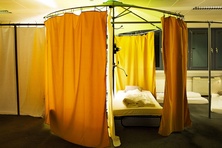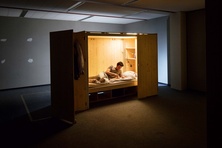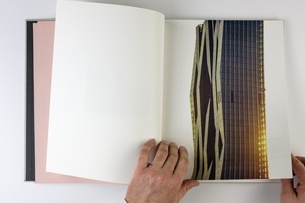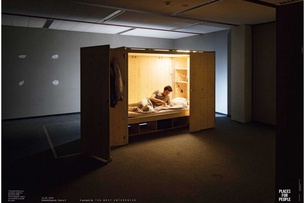Caramel Architekten brought life to a vacant 1970’s office building of around 3,700 square metres with the help of a system of textile elements that, rapidly manufactured and erected, provided short-term privacy and a much improved spatial quality in the sober and functional open-plan spaces. The space-defining yet highly flexible modules were created in cooperation with some of the 280 residents who were accommodated in the emergency shelter for periods averaging between a few days and several weeks. In addition to these central measures the existing communal and external areas including the dining room, bar area, lounge and children’s playground were also remodelled in a way which markedly improved both their functionality and atmosphere. The modules developed by Caramel Architekten are economical and highly transportable as a result of which they can be easily deployed in other locations. Beyond this, the central features of this intervention are individual adaptation and communal production.
The design team EOOS developed a concept for the adaptation of a former school building of around 18,000 square metres close to the centre of Vienna which envisaged both the production and implementation of an entire family of furniture as well as the introduction of such new functions as shops and workshops. The building contains double rooms in which around 400 asylum-seekers were accommodated, long-term, in 2015/2016 but lacked communal and meeting spaces which EOOS thus retrospectively created and equipped with the appropriate furniture. However, the main focus of the intervention was not such furniture as the communal kitchen elements but, principally, the creation of opportunities to work and, as a result, to exchange in the form of an internal communal economy. Among the innovations was a specially developed app designed to facilitate transactions within this economy
The setting of the intervention by the nextENTERprise was a partly empty 1980s office building in the most populous district in the south of the city.
Two floors of the building were adapted for experimental, communal living which brought together refugees and students and was based on the use of specially developed spatial modules that were tested by a range of user groups. These simple, economically producible implants facilitated hybrid forms of living and working in the internal areas while, deployed in the external areas, encouraged communication between residents and the surrounding community. Hence, these elements can be seen as “urban building blocks” which can be used not only temporarily in existing buildings but also in new buildings and, beyond this, in a broad range of urban situations.




